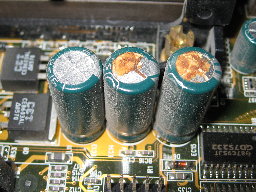katei.fi on 21st century hardware
6 Jul 2008 20:07:20 hardware
katei.fi (and virtual hosts such as wnd.katei.fi) is now
served with the 21st century technology! Cheers!
When I first started using a GNU/Linux box to route my home network back in
early 2001 or so, I relied on shimobe. With 48 MiB of RAM and a CPU clocked
at 33 megahertz, it was not the fastest on the block, but it could run X, FVWM
and Opera when needed. Since shimobe refused to boot from hard drive if two
were attached at the same time, a boot floppy was required. Also, BIOS always
stopped for hard drive error at system start up, requiring user to press F2 to
continue. Naturally this wasn’t an issue, unless power shortages were expected.
shimobe didn’t serve for very long. It was replaced by tomodachi in 2002.
With a 133 MHz Pentium as CPU and whopping 96 MiB of system memory, it was
major update. Still, tomodachi didn’t come without surprises. Even though a
boot floppy was no longer needed, BIOS occasionally failed to detech hard
drives, requiring user interaction. Apart from that, the system always booted
up nicely.
In 2004, zenoo moved in. Boasting 384 megabytes of RAM and a Celeron CPU
running at 333 MHz, zenoo was crowned the new king. Or server. Or old server,
actually. Like its predecessors, zenoo was used when I started using it. It
also followed the tradition that each server had to have its unique quirk.
While it always booted perfectly fine without user intervention, it was picky
about electricity we fed it. Being plugged into wrong socket it refused to run.
No, seriously, it did. I guess our last apartment could’ve had better wiring…
Eventually magic smoke escaped zenoo’s power supply unit, and we had to get a
new one. And couple of years lated another.
zenoo ran smoothly until about a month ago. I wanted to install two new hard
drives for RAID-1, so I shut down the system, installed the disks, put
everything back together, and switched on the PSU. bzz The PSU made
high-pitch buzzing sound and the system refused to start up. I quickly cut the
power, and started sniffing. No, the smoke was still sealed in the PSU. I
detached the disks, and the system started up. Excuse me, a 400-watt power
supply that can’t feed a Celeron and four disks? I found out the system would’t
boot at all with four hard drives. With three, the power supply would make
funny noises. With two, the system would run normally. I ended up disconnecting
the two hard drives, and running the system as I had done before. Later it
turned out the system would now spend one third of its time in IO-wait. This
was the last straw. zenoo would have to go. Later it turned out that zenoo
was suffering from capacitor plague.
After some asking around, I ended up ordering passively-cooled motherboard and
CPU, one gigabyte of RAM and a new PSU. After three weeks of waiting,
everything but the PSU was available. Last Friday I decided I didn’t want to
wait for any longer. I replaced the PSU in my order and took the components
home. I spent the next day setting up the system in a cardboard box, and as the
CPU architecture was upgraded to 64-bit, installing things from scratch. I
copied most of the old configuration, and set everything up. Finally I was
ready to shut down zenoo for good, and reuse its case with modern hardware. I
had to stop for a moment to realise zenoo had served me for four years. It
was my longest serving server so far. It was now time for chikan to take
over.
Following old tradition, chikan decided not to boot up. Or in fact, it
decided not to detect its SATA hard drive. Sigh. I tracked things back to newly
installed 3Com network card. After I had replaced the NIC with another 3Com
card and switched on power, the screen remained blank. That was rather
intriguing as I had just recently used the very same NICs with zenoo without
a single issue. I tried three more 3Com network cards (all five being
3c905-family models) I happened to have. chikan booted perfectly fine with
each one of them. I ended up favouring one of the 3Com cards over a RTL-8139b
card I also had. This was a bit risky choice, as each one of the three used to
have some sort of issue with the computer it used to be in. The particular one
chose used to be in kikai. One day it simply stopped transmitting bits after
being powered for a few hours. Still, I decided to give it a try.
chikan is now fully synchronised with zenoo’s old disks, and it’s running
with some 240 GiB of RAID-1 mirrored disk space for backups. Everything is
blazing fast, and everything is running smoothly – for now. I should’ve done
this long time ago. Here’s the final configuration.
Final configuration
- Intel D201GLY2 motherboard with integrated Celeron 220 CPU (1.2 GHz), with integrated 100 Mb/s NIC. All components passively cooled.
- 1 GiB of Corsair DDR2 CL5 memory
- Nexus NX-8040 400 watt PSU
- Seagate Barracuda ES 250 GB hard drive (system disk)
- Two Seagate Barracuda 7200.10 320 GB hard drives (RAID-1)
- 3Com 3C905-TX NIC